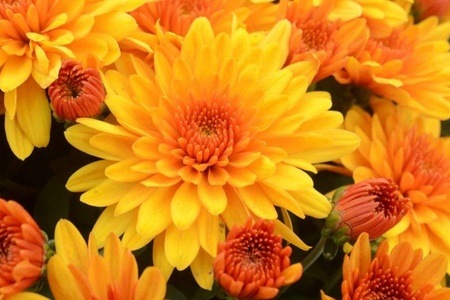
“Fireglow” Chrysanthemum from ProvenWInners.com
“… Lift the dahlias after the first frost, cut them and plunge them in sand or ash in the greenhouse for winter. Sow sweet peas in little pots in the greenhouse. You must tackle the garden with pruning shears, ready for winter. Cut back, always cut back. You will be rewarded come summer.” – The Garden of Lost and Found, by Harriet Evans. © 2019 Venetia Books Ltd.
Although Evans’ advice is meant for a colder climate, this advice is sound for us. Our November weather provides a time to tend to existing plants, and to prepare our gardens for a splendid Spring. Garden centers have a large selection of chrysanthemums, asters, dianthus, violas, delphinium, and other annuals ready for transplanting into the garden this month.
- ‘Tis the season for the bright and beautiful Chrysanthemums, one of the most colorful delights of Fall. They are available in all sizes and colors, from the ground-hugging, full Mini-mums, to the gigantic and hardy open-face cultivars that can reach 3-to-4 feet tall and wide. These sun loving plants will grow best in fertile, well-drained soil, enriched with general-purpose fertilizer. Chrysanthemum is a large genus in the Asteraceae (daisy) family, of which there are thousands of cultivars. Blooming in the fall, the multibranched stems of some varieties are covered with flowers which stand out against the dark green foliage. Other varieties form compact, bushy mounds. Use them for a colorful Fall display in beds, along an edge, in pots, or on the patio or porch. Protect the taller varieties from strong wind. Caution: deer love them! Well worth watching: “Dazzling Chrysanthemums Grower in Australia,” is a 6-minute video that shows an amazing array of these flowers grown and bred near Perth, at the southwestern edge of the continent.
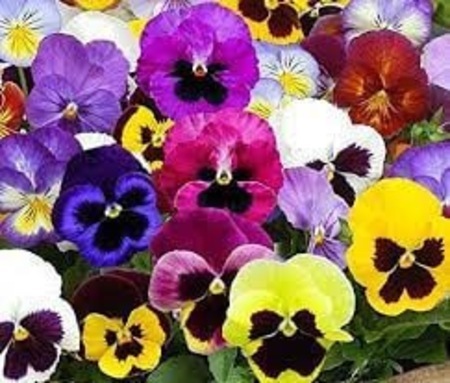
Happy Face Pansies from Bexar County AgriLife
- Low-growing pansies will add color to any container or flower bed as the days get cooler. They are one of the “cool season” annuals that can be counted on to keep producing through the first frost. Along with dianthus, they can be used to cover over bare spots where annuals have been removed, or over fresh tilled soil where spring-flowing bulbs have been planted. Because deer tend to root around freshly turned earth, a high-nitrogen fertilizer such as blood meal or Milorganite® sprinkled over the freshly planted bulbs will help to keep the deer at bay.
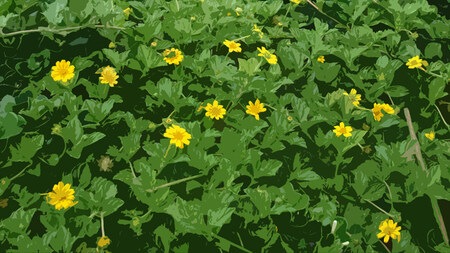
Wedelia Painting from TheSurvivalGardener.com
- Groundcovers are often low maintenance and will add a nice texture and color change to the lawn. One option is Wedelia, which forms a dense ground cover eight to ten inches in height, and will grow in sun and in shade. Topped with yellow daisy-like blooms, it is very drought tolerant once established. Wedelia is a genus of flowering plants in the family Asteraceae; one of the genera commonly called “creeping-oxeyes,” and are often planted to prevent erosion. They are fast-spreading to the point of being somewhat invasive, so care must be taken to keep them contained. Zones 8b-11.
- Hummingbirds could be around thru mid-November, so maintain their feeders until then. It’s the shortening length of daylight that triggers their migration, not the availability of food.
- Keep fallen leaves from piling up and ruining your lawn. Seventy-five percent of the nutrients that a tree took up during the growing season are contained in its fallen leaves. Let’s gather them up for the compost pile. For more on this an expansive article from Texas A&M: “Don’t Bag It — Compost It.”
- The recommendation by AgriLife to over-seed a lawn in zones 8 and 9 with winter rye grass is not solely for aesthetics, especially in the higher areas of Comal County. The additional cover can act as a barrier to a killing frost.
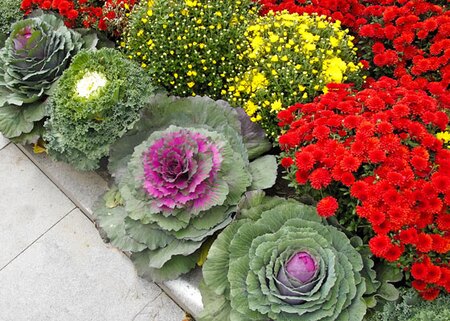
Ornamental Cabbage and Kale from GardeningKnowHow.com
- Ornamental cabbages and kale grow in a wide range of colors and shapes. Take advantage of their visual texture by planting them at the edge of beds, or together in containers. They like a sunny location and a moderately moist, rich soil. Bury the stem so that the lowest leaves are flush with the soil surface. While ornamental cabbage and kale are edible, they tend to have a bitter flavor, and are often used in a culinary setting as garnishes.
- Petunias are still available at garden centers and other plant outlets. They are quite reliable as cool-season bedding plants for all elevations here. They are hardy to around 20 degrees, and will brighten our landscapes from October to May or early June. The planting season continues to early March. If temperatures in the low 20s are predicted, move potted petunias indoors or to a protected location, and throw covers over any petunias that are planted in the garden.
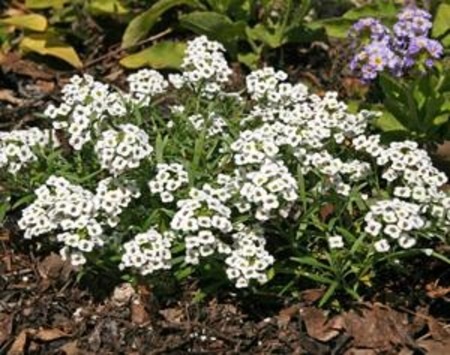
Sweet Alyssu (Lobularia maritima) from UWM Horticulture Extension
- Sweet Alyssum (Lobularia maritima ) is a cool-weather plant in South Central Texas, growing as ground cover, edging, and in containers and flowerbeds from fall to spring. The flowers are edible, and, as many colors are available, Alyssum flowers can be a colorful ornament for many culinary purposes. They grow in full sun to partial shade in well-drained soils. University of Wisconsin-Madison Horticulture Extension gives us all the information we need to cultivate this delightful winter plant.
- Edge a garden area or a planter with curly parsley and/or carrots. The green tops will add a nice visual texture. Carrots usually mature in 60-80 days, so use short-day carrots such as Nantes; days-to-maturity should be listed on the back of the seed packet. HGTV has an all-round article for more information.
- A vegetable garden can be a riot of colors and shapes by choosing an assortment of varieties. Lettuces, for instance, come in many shades of green and red, tall and bushy, compact and low- growing. Interspersed with root vegetables and other greens such as chard, the visual choices are endless. The lettuce can be harvested for use and re-seeded. Remember to sprinkle the seeds on top of the soil, as they need exposure to sunlight to germinate.
- For a continuous harvest of spinach, start seeds indoors, then plant them in the garden every few days. Texas A&M recommends the varieties Bloomsdale, Early Hybrid and Melody.
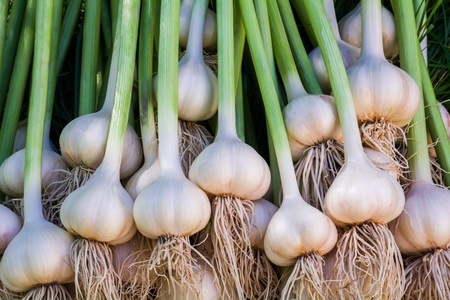
Garlic Harvest from IAmCountrySide.com
- Garlic can be planted in South Central Texas through November and into December. It is a cool-season vegetable that is planted in the Fall for harvesting in the Spring. Garlic requires 6 to 8 weeks of cool weather (below 40 degrees F) to develop properly. That means you need to get it in the ground sometime from early October to early December, Central Texas Gardener has the ‘how-to’. If you are debating whether to plant the hard-neck or the soft-neck varieties, get more information here.
- EAT YOUR GREENS! In a list of “Powerhouse Fruits and Vegetables from the Centers for Disease Control, the Top Ten greens from the list that contain the most valuable nutrients are: Watercress; Chinese Cabbage; Chard; Beet Greens; Spinach; Chicory; Leaf Lettuce; Parsley; Romaine Lettuce; and Collard Greens. That’s something to consider when planting your winter garden.
- EAT YOUR SEEDS! WebMD.com informs us that a 1oz. serving of pumpkin seeds has about 2.5 grams of omega-6 and 22 milligrams of omega-3 fat. In addition, the protein in pumpkin seeds is a high-quality protein, like soy protein, that has all your essential amino acids. You can scoop seeds out of a carving pumpkin and roast them yourself. Chia seeds are tiny powerhouses full of fiber, protein, and omega-3s, along with pumpkin and other seeds, according to the Texas A&M “Dinner Tonight” program.
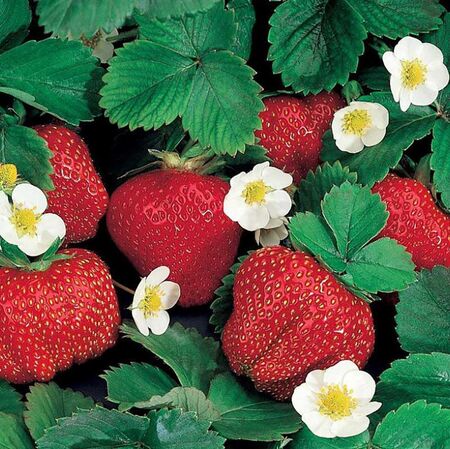
Chandler Strawberry from Texas A&M AgiLife
- Now is the time to plant Strawberries! “Strawberries thrive in a well-drained soil and are especially well adapted to slightly acidic sandy loams. The varieties Chandler, Sequoia, Seascape, Albion, Elan, and Cardinal are some of the best strawberries to grow in our San Antonio area,” says David Rodriguez, Bexar County horticultural agent. Chandler is a spring-bearing variety that produces high-quality fruit and is a top choice for this area. Albion is an everbearing variety that’s high yielding, tolerates heat and humidity, and has excellent disease resistance. Buy strawberries in 4-inch containers, and transplant them to rows in a raised bed, in hanging baskets or in containers in full sun. The soil needs to drain well. These strawberries are relatively cold tolerant, but should be protected if temperatures drop below 20 degrees
by CMG Adrienne M
Sources: These and other web sites: cdc.gov; aggie-horticulture.tamu.edu; ProvenWinners.com; SavvyGardening.com; GardeningKnowHow.com; CentralTexasGardener.com; plants.ces.ncsu.edu; InspireTaste.net; CDC.gov.; The University of Wisconsin Horticulture Extension; The North Carolina Extension Garden Plant Toolbox; The University of Wisconsin-Madison Horticulture Extension; https://bexar-tx.tamu.edu/homehort/archives-of-weekly-articles-davids-plant-of-the-week/garlic/; https://dinnertonight.tamu.edu/super-seeds/